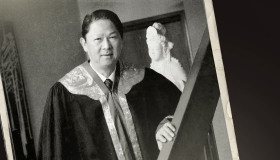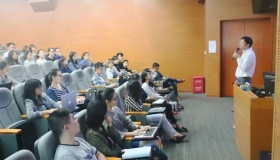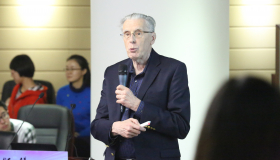Academic paper of CUHK-Shenzhen undergraduate received by RSC Adv
? ? ? ?Recently, a paper entitled "TE-C36 carbon: a new semiconducting phase with an all-sp3 bonding network" by Xu Yanheng was received by RSC Adv, a journal of the Royal Society of Chemistry. Xu, the first author of this paper, is an undergraduate student from the Robotics and Intelligent Manufacturing Laboratory of CUHK-Shenzhen (Year 3, Electronic Information Engineering, School of Science and Engineering).
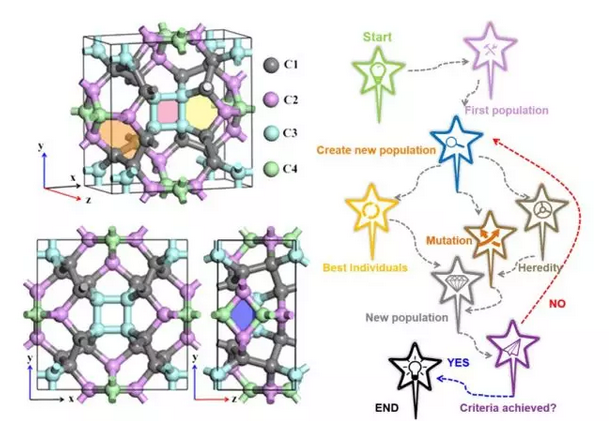
Left: TE-carbon crystal structure; different colors represent carbon atoms in different coordination environment
Right: An example of intelligent screening of material structure properties based on genetic algorithms
?
The bulk carbon phase materials represented by diamond is mostly composed of the perfect sp3 hybrid orbital and thus is very hard and versatile. However, the band gap can often be very big (UV energy range, greater than 5.0eV) in an indirect form, restricting the applications of pure carbon material in the photoelectric. Finding carbon materials that have a direct band gap and can absorb visible light is of great significance. In his work, a direct band gap bulk phase superhard carbon material with an energy band gap of 2.25 eV in the visible light absorption range has been successfully predicted by genetic algorithms of material structure and intelligent screening of energy band characteristics. It provides a new choice for the design and application of a new generation of pure carbon superhard semiconductor optoelectronic materials.
?
Xu Yanheng, graduated from Huzhou Middle School in Zhejiang Province, is now a third-year undergraduate majoring in Electronic and Information Engineering at the University. He applied for a comprehensive assessment test in 2015 and was admitted to the University with honors. Since the sophomore summer, he has been involved in the Materials Informatics group at the Robotics and Intelligent Manufacturing Laboratory with support from the Institute's Pinocchio Club and the Undergraduate Research Awards (URA). His supervisor is Prof. Zhu Xi from School of Science and Engineering.
?
URA is one of the features of undergraduate education in CUHK-Shenzhen. This research funding, specifically designed for undergraduates, will nurture students’ interest and ability to explore the unknown and conduct research.
?
Applicants for the URA program must be undergraduates at the Chinese University of Hong Kong, Shenzhen and should have completed one academic year of study prior to the commencement of the research project. Through the application materials and the interview examination, the URA Committee will select the best candidates according to the students' academic performance, research proposal and teacher's recommendation. Successful applicants will be funded by the University and carry out research work under the guidance of their supervisors. Each student needs to submit a project completion report to the committee after the project is done.
?
The Robot and Intelligent Manufacturing Laboratory attaches great importance to students' scientific professional quality. In December 2017, undergraduates Zhang Guilin and Lei Xiangyu, led by Prof. Qian Huihuan, reported on their research work of two laboratories at the IEEE International Conference on Robotics and Biomimetics (ROBIO). Their papers were included in ROBIO 2017 conference proceedings.
?
Xu Yanheng joined the Robotics and Intelligent Manufacturing Laboratory and the Pinocchio Club at the end of August 2017. My research interests are in materials informatics. “Although I am not a material student, after the introduction of the laboratory by teachers and the seniors, I had a great interest in material physics. ” He said. The research can be simply described as the application of artificial intelligence in engineering materials. Specifically, the genetic algorithm is used to construct the crystal phase of the materials, and then the physical characteristics of the respective materials are selected through reverse feedback from the point of molecular orbital characteristics. In this process, finding a stable and undetected structure is more difficult, and it is likely to consume a large number of computing resources. Many materials are found to be already existing after optimized or difficult to be statically or thermodynamically stable. In contrast, the TE-C36 Carbon the research team selected was derived from a recently discovered T-Carbon and more stable in energy and entropy, which made the study fewer detours. In general, the paper mainly expounds some properties of this new structure and proves that it can be stable under the theory.
?
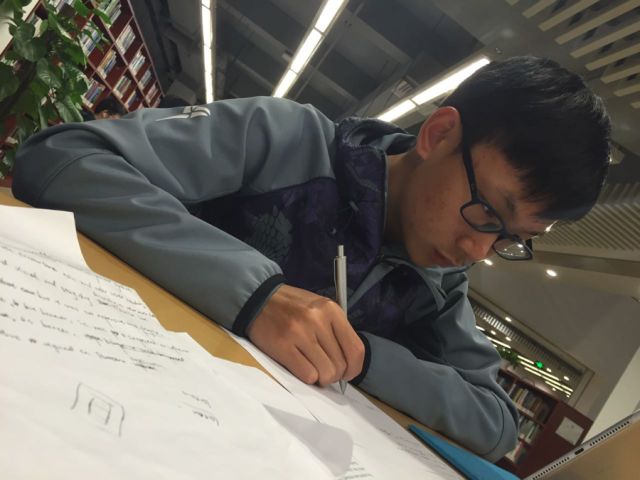
?
“The teachers and seniors of Robotics Lab and Pinocchio Club gave me a great help and encouragement. The good work done by my friends Zhang Guilin and Lei Xiangyu under the guidance of Prof. Qian Huihuan also pushed me forward so that I could keep working hard. At the beginning of the research work, Professor Zhu Xi explained to me the whole material science research method, the reasons to calculate these physical quantities, the significance of their representation, and what kind of structure can be deemed stable and so on. He also taught me a lot of material big data knowledge. He would also make suggestions on the results I got during the calculation and analysis. Dr. Lu Yihua from the lab taught me a lot of software usage related to material simulation and machine learning, and also helped me to solve various abnormalities that occurred in the calculation process. At the same time, with the approval of Associate Vice President Professor Cai Xiaoqiang, I received the help of the Undergraduate Research Awards (URA) to support my further research.”?He said.
?
?During research, Xu Yanheng had modified the paper and optimized the data for many times. He said The research work of excellence and rigorous argumentation not only enabled him to master a lot of theoretical knowledge of materials science, but also helped him learn a lot of application prospects related to artificial intelligence. “In the process, I have laid a solid professional foundation with a broader perspective and more opportunities ahead. Most importantly, I can understand and learn real cutting-edge technologies,” He said.
?

